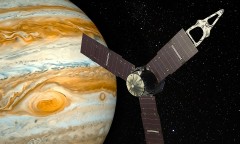By Jenia Cane, | February 18, 2017

Built by Lockheed Martin and operated by NASA's space laboratory, Juno has been circling Jupiter since July 2016. (Kevin Gill/CC BY-SA 2.0)
The team behind NASA's Juno spacecraft has shelved its original plan of reducing the number of days the space probe will circle Jupiter. Juno's orbiting period was supposed to be cut down from 53 days to just 14 days, but the space administration decided to forego this move due to a glitch in the spacecraft's propulsion system.
Like Us on Facebook
Built by Lockheed Martin and operated by NASA's space laboratory, Juno has been circling Jupiter since July 2016. The space authority was set to carry out an engine burn to cut down the spacecraft's orbiting time, but this will no longer be feasible because of technical issues concerning the two helium valves of the space probe.
"During a thorough review, we looked at multiple scenarios that would place Juno in a shorter-period orbit, but there was concern that another main engine burn could result in a less-than-desirable orbit," explained Rick Nybakken, Juno project manager at NASA's Jet Propulsion Laboratory (JPL) in Pasadena, California. "The bottom line is, a burn represented a risk to completion of Juno's science objectives," Nybakken added.
NASA's Juno spacecraft cost the US government $1.1 billion. Its primary mission is to collect data on Jupiter's structure, composition, and its gravitational and magnetic fields.
The spacecraft was originally scheduled to conduct 30 flybys within the proposed 14-day period. However, even if the space probe continued to circle Jupiter until July 2018, it would only be able to make 12 close flybys due to the limitations of its 53-day path.
In the meantime, Scott Bolton, Juno's principal investigator from Southwest Research Institute, noted that the NASA spacecraft's longer orbits would not affect the mission's data gathering. Bolton said that sticking to the original plan may even come with more benefits, reported the Los Angeles Times.
According to Bolton, the longer orbits will allow the space probe to study the more distant parts of Jupiter's magnetosphere in a manner that has not been previously done by other missions. Moreover, NASA's Juno spacecraft will be able to obtain more accurate measurements of the planet's gravitational field and enable the research team to map out the planet's core.
-
Use of Coronavirus Pandemic Drones Raises Privacy Concerns: Drones Spread Fear, Local Officials Say

-
Coronavirus Hampers The Delivery Of Lockheed Martin F-35 Stealth Fighters For 2020

-
Instagram Speeds Up Plans to Add Account Memorialization Feature Due to COVID-19 Deaths

-
NASA: Perseverance Plans to Bring 'Mars Rock' to Earth in 2031

-
600 Dead And 3,000 In The Hospital as Iranians Believed Drinking High-Concentrations of Alcohol Can Cure The Coronavirus

-
600 Dead And 3,000 In The Hospital as Iranians Believed Drinking High-Concentrations of Alcohol Can Cure The Coronavirus

-
COVID-19: Doctors, Nurses Use Virtual Reality to Learn New Skills in Treating Coronavirus Patients









